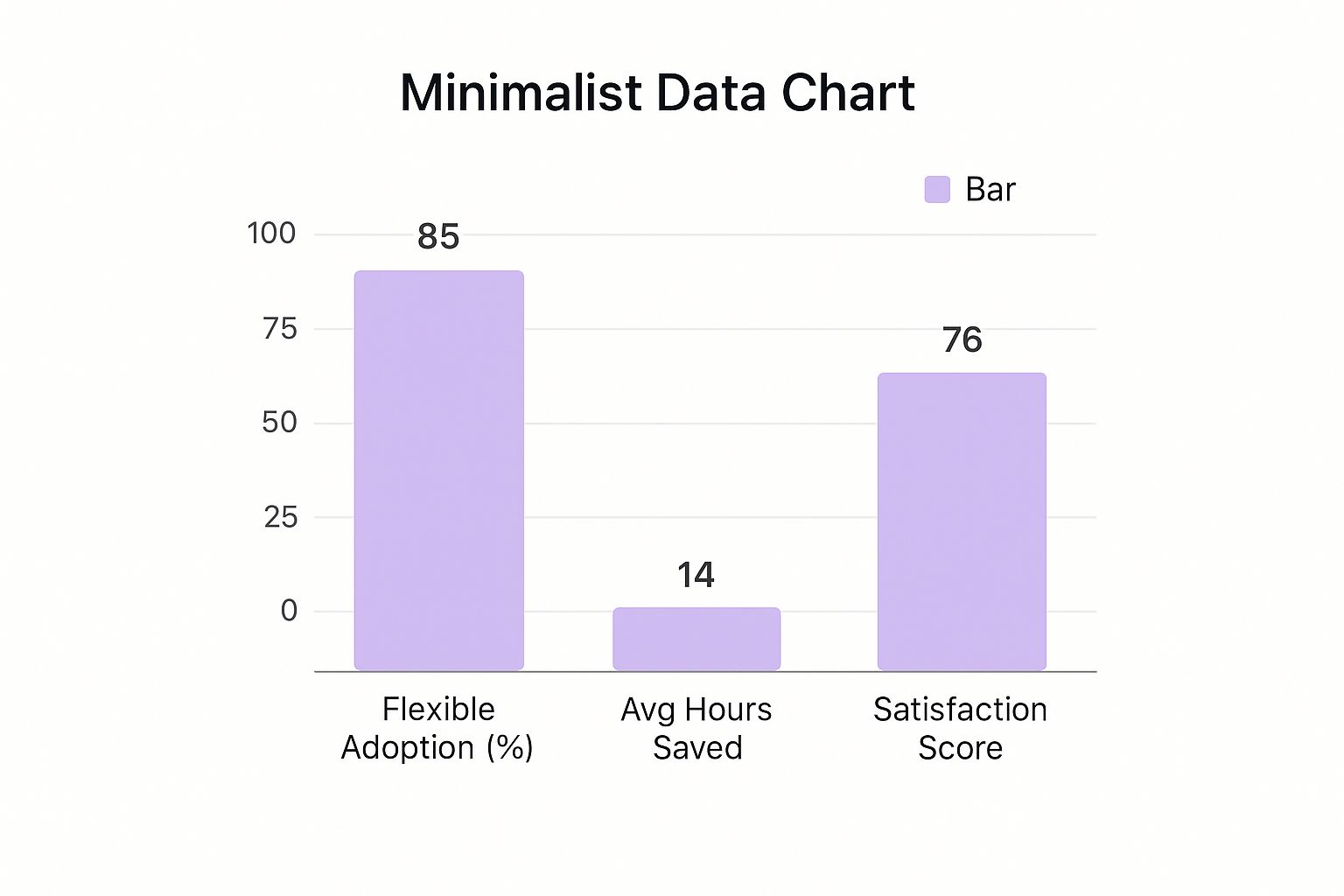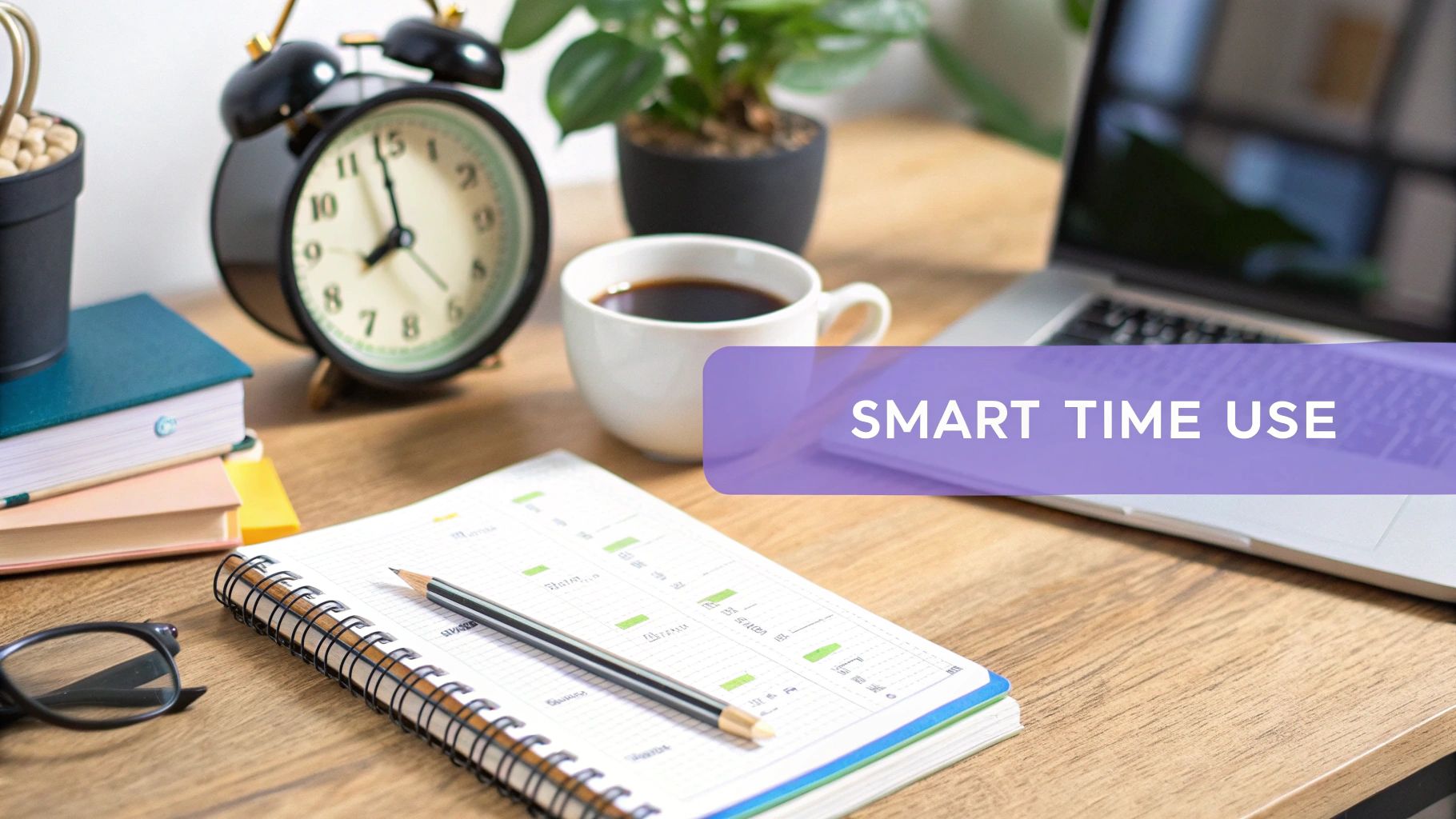How to Improve Work Life Balance: Tips for a Happier You
Discover effective ways on how to improve work life balance. Achieve harmony with practical tips on boundaries, time management, and flexibility.
Let's be real—achieving a healthy work-life balance feels harder than ever. The first step is often just admitting how tough the modern work world makes it. It takes a deliberate, conscious effort to reclaim your time. This isn't about working less, but about working smarter by setting firm boundaries and changing how we think about productivity.
Why Finding Work-Life Balance Is So Hard Today

If you feel like you're fighting a losing battle for balance, you're not alone. We're all grappling with an "always-on" culture. That digital leash—the endless stream of emails, Slacks, and Teams notifications—keeps us mentally chained to our desks long after we've shut our laptops.
The lines between the living room and the office have practically evaporated for many of us, making it incredibly difficult to truly unplug. This constant connection has normalized a culture of overwork, where there's an unspoken pressure to prove your dedication through long hours and instant replies. It's a broken mindset that equates being busy with being valuable, and it shoves our personal well-being to the bottom of the priority list.
The Blurring of Professional and Personal Worlds
The way we work has changed dramatically, but our habits are still playing catch-up. The very technology designed to give us more flexibility has ironically become a major source of stress. When your work phone is always on the nightstand, the urge to check "just one more email" can quickly steal your evenings and weekends.
This creates a massive mental load. You aren't just managing professional duties anymore; you're constantly trying to switch gears between work tasks, family needs, doctor's appointments, and trying to squeeze in a social life. The brainpower it takes to jump between these roles without any real downtime is a fast track to feeling completely drained.
The core challenge isn't just about managing your time; it's about managing your energy and attention. When work consistently spills over, it depletes the very resources you need to be present and engaged in your personal life.
The fallout from this imbalance is no small thing. Chronic stress and exhaustion slowly erode your mental and physical health, leaving you in a state of perpetual fatigue. This is why knowing how to avoid burnout at work is so crucial—it’s the inevitable result of letting this imbalance go unchecked for too long.
By getting honest about these root causes, from societal pressures to our own habits, we can finally start putting effective strategies in place to build a more sustainable and fulfilling life.
Drawing Your Line in the Sand with Real Boundaries

Let's be honest: setting boundaries is probably the single most effective thing you can do for your work-life balance, but it's also the one that feels the most uncomfortable. We worry it comes across as confrontational or that we're not a team player.
The truth is, protecting your personal time isn't about being difficult; it's about being sustainable. The best boundaries are set proactively, long before you're burned out and responding from a place of frustration.
This starts with something simple: define your start and end times for the day. Then, the hard part—actually stick to them. If you work from home, this is absolutely non-negotiable. When it's time to clock out, close the laptop, physically step away from your desk, and let your brain shift gears. That simple routine trains you to recognize when the workday is truly done.
How to Communicate Your Boundaries Without a Bullhorn
You don’t need to send out a company-wide memo announcing your new schedule. The most powerful way to communicate your boundaries is to simply live by them.
Your actions will always speak louder than words. A great first step is updating your Slack or Teams status to "Signing off for the day" at the same time every evening. Consistency is everything here; it teaches people what to expect.
Of course, after-hours requests are going to happen. The way you handle them makes all the difference. Ignoring a message can create anxiety (for you and the sender), but you don't have to jump on the task, either.
Acknowledge the request, but gently reinforce your boundary.
Scenario: It’s 7 PM and your manager pings you, asking for a "quick update" on the Miller account.
Your Response: "Got it, thanks! I've logged off for the evening, but I'll make this my first priority in the morning and will have an update for you by 9:30 AM."
See what that does? It shows you're responsible and on top of it, but it does so without sacrificing your personal time. It’s professional, respectful, and crystal clear. The more you do this, the more your team will naturally start to respect your work hours.
Creating Digital Fences
Your physical workspace isn't the only place that needs a boundary; your digital world does, too. That constant buzz from notifications on your phone is a direct line from the office into your living room. Cut it off.
Thankfully, you can use technology to build these "digital fences" for you.
- Schedule Send is Your Best Friend: Got a brilliant idea at 10 PM? Fantastic. Write the email, but use the "schedule send" feature to have it arrive at 8 AM tomorrow. This prevents you from kicking off a late-night email chain.
- Embrace Focus Modes: Your smartphone’s built-in focus or do-not-disturb modes are incredibly powerful. Set them up to automatically silence work-related apps outside of your defined hours.
The amount of time we spend logged on has a direct and measurable impact on our quality of life. Just look at Italy, where only 3% of employees work very long hours and the country scores a remarkable 9.4 out of 10 for work-life balance. This stands in stark contrast to places where working over 50 hours a week is common, leaving little time for anything else. You can dig into more of these kinds of global stats on Lifehack Method.
Ultimately, building and maintaining these boundaries is an act of self-preservation. It’s what allows you to show up to work tomorrow refreshed, focused, and ready to do your best work.
Making Flexible Work Actually Work for You
So you’ve got a flexible work schedule. That’s a huge win, but it's not a magic ticket to perfect work-life balance. I’ve seen countless people get the freedom they wanted, only to find themselves working more than ever. The secret isn't just having flexibility; it's being intentional about how you use it.
Without a solid plan, the lines between your living room and your office, or your personal time and your work time, get incredibly blurry. You have to consciously build a structure that lets you dive deep into your work and then completely unplug when the day is done.
Structuring Your Flexible Week
First things first, you need a framework. A hybrid or remote setup gives you the power to design your week around your own energy cycles and life commitments, not just the traditional 9-to-5.
Try time-blocking. Maybe you designate Tuesday and Thursday mornings as your "deep work" zones. That means notifications are off, and you're tackling the big, brain-draining projects. By proactively walling off this time, you guarantee you're making real progress on what matters most.
A big part of this is mastering asynchronous work schedules, which allows your team to collaborate without everyone having to be online simultaneously. It’s a game-changer for taking back control of your day.
This chart really drives home how much of an impact this shift can have on employees.
As more companies get on board with flexible policies, you can see a direct link to employees saving time and feeling much more satisfied with their jobs.
Creating a Workspace That Works for You
Your physical environment has a massive impact on your mental state. If you’re trying to work from the kitchen table or, even worse, your bed, it becomes almost impossible to mentally clock out.
You need to carve out a dedicated space for work. It doesn't have to be a whole room—even a small corner will do. The point is to create a spot that tells your brain, "Okay, we're in work mode now." When you leave that space, the workday is over.
Set it up with everything you need to be productive and comfortable. Our guide for remote workers has some great pointers on creating an ergonomic home office. This is also where a tool like DeskBreak comes in handy, reminding you to get up, stretch, and give your eyes a rest. Those little nudges are what prevent the burnout that comes from being glued to a screen all day.
A dedicated workspace isn’t a luxury; it's a psychological tool. It creates a physical boundary that reinforces the mental boundary between your job and your personal life.
The numbers back this up. In the United States, 50% of full-time employees have jobs that could be done from home. For those who are fully remote, a massive 85% say that flexibility has dramatically improved their work-life balance. It just goes to show that when you manage it right, flexibility is one of the most powerful tools for building a healthier, happier life.
Time Management That Frees Up Your Life

Let's get one thing straight: better time management isn't about cramming more work into your day. It’s about making your work hours so focused and productive that you can actually log off on time—and not feel guilty about it.
If your to-do list feels less like a plan and more like an infinite scroll of doom, it’s a sign that your current approach isn't working. The real goal is to work smarter, not harder.
The first step? Figure out where your time actually goes. I always suggest a simple one-week time audit. Just jot down what you're doing in 30-minute blocks. You’ll probably be shocked at how much time gets eaten up by small distractions, context switching between tasks, or "quick" social media checks. That awareness alone is half the battle.
Building Momentum with Proven Techniques
Once you have a clear picture of your day, you can start applying frameworks designed for deep focus. These aren't just theories; they're practical methods people swear by.
A great place to start is the "Eat the Frog" method. It's simple: identify your most dreaded, most important task of the day—your "frog"—and tackle it first thing. Getting that out of the way creates an incredible sense of accomplishment that carries you through the rest of the day.
Another game-changer is time blocking. Instead of just reacting to a long list of tasks, you schedule specific blocks on your calendar to work on them. For instance, you might block out 9:00 AM to 10:30 AM for "Write project brief." During that time, that’s all you do. No email, no Slack, just pure focus.
Choosing the Right Strategy for You
Different methods work for different people and different types of work. Here’s a quick rundown of some of the most effective techniques I've seen.
Time Management Technique Comparison
| Technique | Best For | Core Principle |
|---|---|---|
| Pomodoro Technique | Creative tasks, easily distracted individuals | Work in focused 25-minute sprints, followed by a 5-minute break. |
| Time Blocking | People with varied roles, project-based work | Assign every part of your day to a specific task or "block" on your calendar. |
| Eat the Frog | Procrastinators, anyone with big-picture goals | Tackle your most important and challenging task first thing in the morning. |
| The Eisenhower Matrix | Leaders, managers, people with many incoming requests | Categorize tasks into four quadrants: urgent/important, important/not urgent, urgent/not important, and not urgent/not important. |
Take a look at your own work style. Are you someone who thrives on short bursts of intensity, or do you need long, uninterrupted stretches to get in the zone? Your answer will point you toward the right technique.
Maintaining Energy and Focus
Working for eight straight hours is a recipe for burnout. The real secret to a productive day is managing your energy, not just your time. This is where breaks become non-negotiable.
The Pomodoro Technique is incredibly popular for this very reason. It forces you to take breaks. You work in a focused 25-minute burst, then take a 5-minute break. After four of these cycles, you take a longer break. It trains your brain to focus intensely while guaranteeing you step away to recharge.
Want to give it a shot? You can use a simple online tool like the DeskBreak Pomodoro Timer to get started.
Key Takeaway: The best time management system is the one you’ll actually stick with. Don't be afraid to experiment and combine different methods until you find what helps you do your best work without draining your energy for the life you have outside of it.
By finding the right mix of these strategies, you're not just getting more done. You're building a workday structure that respects your time and mental energy, making it much easier to truly disconnect when the day is over.
How Supportive Company Policies Make a Difference
https://www.youtube.com/embed/UKO5jDqA0Lo
While your personal habits are a huge piece of the puzzle, a supportive workplace can be the difference between just surviving and actually thriving. When a company actively invests in its people's well-being, the quest for better work-life balance becomes a shared goal rather than a solo battle.
These policies aren't just feel-good perks; they're the foundation of a culture that gets one simple thing right: happy, healthy people do the best work.
Think about the real-world impact of generous paid time off. It’s not just about taking a vacation. It's about having the space to recharge your batteries, handle life's curveballs, and return to your desk feeling clear-headed and focused. Force employees to choose between their health and their paycheck, and you've got a surefire recipe for burnout.
Building a Foundation of Well-Being
The best companies go beyond the basics. They understand that life is messy and unpredictable, and their policies reflect that reality. They create a safety net that lets people show up for the most important moments in their lives without worrying about their careers taking a hit.
Some of the most impactful policies I've seen include:
- Comprehensive Parental Leave: Giving parents ample time to bond with a new child sends a powerful message that the company values families. It's a game-changer for reducing stress and building loyalty.
- Flexible Sick Days: Whether you've got the flu, need a mental health day, or are caring for a sick kid, flexible leave policies demonstrate trust and empathy.
- Accessible Mental Health Resources: Offering confidential counseling and mental health support acknowledges that our psychological well-being is just as critical as our physical health.
Supportive policies are a direct reflection of a company's values. They show a commitment to employees as whole people, not just cogs in a machine, which is the cornerstone of a healthy and sustainable work culture.
Lessons from Global Leaders in Balance
If you look at countries that consistently top the charts for work-life balance, you'll spot a common thread: strong social and corporate policies. These nations prove that prioritizing well-being on a grand scale leads to a happier, more productive population.
A few countries really stand out. For instance, New Zealand has an impressive work-life balance index score of 86.9 out of 100. This is driven by things like 32 days of statutory annual leave and 26 weeks of fully paid maternity leave.
Likewise, Northern European countries like Norway offer up to 49 weeks of 100% paid maternity leave, a clear signal of a deep national commitment to family and personal time. You can dig into more data and see how these policies influence global rankings in the Global Life-Work Balance Index.
The lesson here is clear. Whether at a national or a corporate level, investing in policies that give people time and security isn't just a "nice-to-have"—it's a powerful strategy for creating an environment where everyone can flourish, both at work and at home.
Got Questions About Work-Life Balance? Let's Dig In.
Even with a solid game plan, you're going to hit roadblocks trying to improve your work-life balance. It's totally normal. You might feel a little lost, wondering how to bring this up with your manager or what to do when your whole company seems to celebrate burnout.
Let's walk through some of the most common hurdles with advice that actually works.
How Do I Talk to My Boss About Work-Life Balance?
This conversation can feel really intimidating, I get it. The trick is to frame it as a partnership. You're not there to complain; you're there to find a way to be your most productive, sustainable self, which is a win for everyone.
First, book a proper meeting. Don't just catch them in the hallway. A scheduled one-on-one shows you've thought this through and you’re serious about finding a real solution.
Then, come prepared with specifics and ideas.
Instead of saying: "I'm just so overworked."
Try this: "I'm really committed to hitting our goals, but I've been logging on until 8 PM most nights to keep up. I'm worried about burning out down the line. Could we review my current projects and see if there's a way to prioritize things so I can be more effective during my core hours?"
See the difference? This approach is all about productivity and long-term performance. You're showing you’re proactive and want what's best for the team, which is a conversation any good manager will be open to.
What if My Company Culture Glorifies Overworking?
Trying to single-handedly shift an entire company's mindset is a tall order. But here's the good news: you don't have to. You can start by carving out a little pocket of sanity for yourself.
The most powerful thing you can do is lead by quiet example.
- Start logging off at a reasonable hour, consistently.
- If you think of something after hours, draft the email but use the "schedule send" feature for the next morning.
- Take a real lunch break. Seriously, get up and walk away from your screen.
Your consistency sends a signal to others that it's okay to have boundaries. You'd be surprised how many of your colleagues are just waiting for someone else to go first. Find a few work friends who feel the same way and you can support each other in making it the new normal.
Can You Really Have Balance in a Demanding Job?
Yes, you absolutely can. But it demands a different kind of discipline. In a high-pressure role, balance isn't a perfect 50/50 split every day. It's about being incredibly focused at work and fiercely protective of your time off.
This means when you're on the clock, you're 100% on. No distractions. When you're off the clock, you need to be 100% off. No "just checking one email."
Treat your personal time with the same respect you give a client meeting. Block it out on your calendar—the gym, dinner with your family, an hour to read a book—and honor that commitment. For parents navigating this, finding actionable strategies for work-life balance for moms can offer some much-needed, tailored advice. At the end of the day, your downtime has to be non-negotiable.
Ready to put these ideas into practice? DeskBreak is built to weave healthy habits directly into your workflow. With smart reminders to stretch, rest your eyes, and take a real pause, it helps you protect your well-being without even thinking about it. Get ahead of burnout and take back your focus at https://www.deskbreak.app.